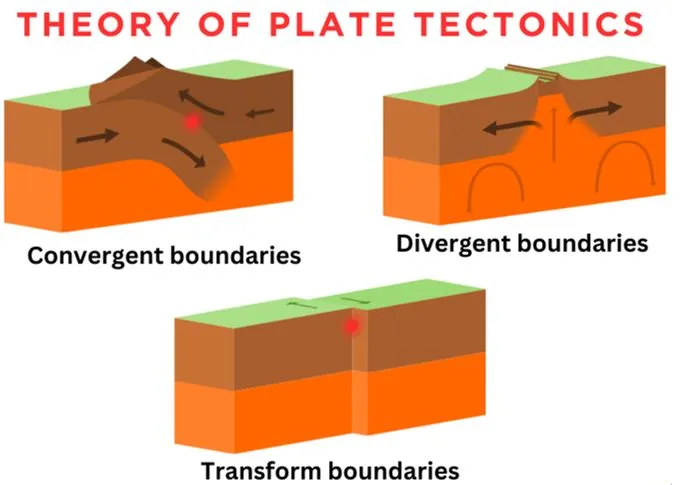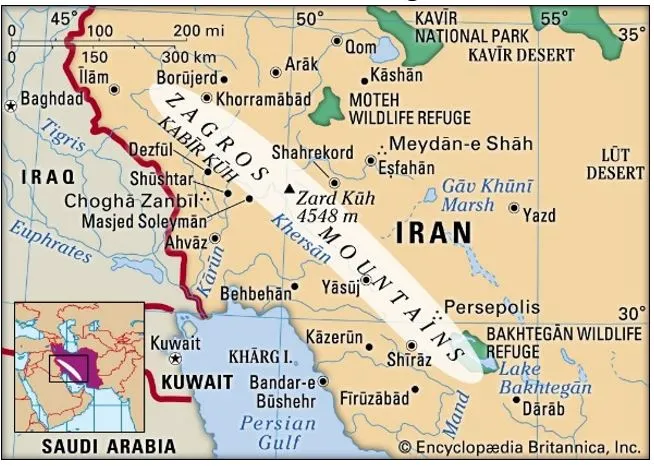

22nd February 2025 (11 Topics)
Mains Issues
Context
The northern region of Iraq, especially around the Zagros Mountains, is slowly sinking into the Earth. This process is happening very slowly, over millions of years, and is caused by forces deep inside the Earth. This is not something that can be seen happening quickly like a sinkhole; it's a very gradual change.
Key-findings of the Study
- Neotethys Oceanic Plate Rupture: The study reveals that the Neotethys oceanic plate (once the seafloor between the Arabian and Eurasian continents) is slowly breaking off horizontally. This rupture is extending from southeast Turkey to northwest Iran.
- The sinking of this oceanic plate (part of plate tectonics) beneath the Earth's surface contributes significantly to the bending and subsiding of the region’s surface.
- Surface Depression and Sediment Accumulation:
- Over millions of years, the immense weight of the Zagros Mountains has caused the Earth's surface around the mountains to bend downward. Sediments eroded from the mountains accumulated in the depression, forming plains like Mesopotamia in the Middle East.
- Depression of 3-4 km deep is observed, which could not be solely explained by the weight of the mountains. Instead, the sinking oceanic plate beneath the region is playing a key role in pulling the surface downward, making space for more sediment to accumulate.
Why is it Sinking?
- The sinking is caused by a tectonic process. The Earth’s surface is made up of large plates, and these plates are constantly moving.
- Tectonic Plates: The plates that make up the Earth's surface are constantly moving, and where they meet, they can cause changes to the land above.
- Neotethys Slab: Below the Zagros Mountains, there is a piece of ocean floor called the Neotethys slab. This slab is slowly sinking into the Earth’s mantle (the layer below the crust). This process started millions of years ago when the oceanic plate broke off, and it's still happening today.
- Plate Collision: The sinking is happening because the Arabian Plate and the Eurasian Plate are colliding. This collision has created the Zagros Mountains, and the sinking slab is pulling the land down with it.
Fact Box:Key Concepts:
Key-location Zagros Mountains (Kurdistan Region, Iraq):
Mesopotamia (Middle East):
|


Mains Issues
Context
India and Qatar have a long-standing trade relationship, primarily fueled by India's heavy imports of Liquefied Natural Gas (LNG) from Qatar. As India’s energy demand grows, LNG plays an even bigger role. During a recent state visit by Qatar's Amir, both nations agreed to double their bilateral trade to $28 billion annually by 2030.
India’s LNG Imports Surge
- India is the 4th largest importer of liquefied natural gas (LNG) from Qatar, USA, Russia and Australia.
- Qatar is India’s largest LNG supplier, contributing to nearly 50% of India’s LNG imports.
- India’s LNG imports from Qatar in 2024 were 82 million tonnes, making up 38.8% of total LNG imports.
- Future Growth in LNG Imports: India’s LNG demand is expected to grow significantly over the next few years due to the government’s plan to increase the share of natural gas in the energy mix to 15% by 2030.
- As a result, India’s LNG imports will double by 2030 to 65 bcm (billion cubic meters) annually.
- Qatar’s LNG Export Capacity Expansion: Qatar is set to increase its LNG export capacity to 142 million tonnes per year (mtpa) by 2027, nearly doubling its current capacity of 77 mtpa.
- This will further cement Qatar as India’s leading LNG supplier.
The US Factor:
- The United States is becoming a strong competitor to Qatar in supplying LNG to India, currently being the second-largest LNG supplier to India.
- The US is expanding its LNG exports, and Indian companies are also exploring long-term contracts with US suppliers.
Government Initiatives
|


Mains Issues
Context
In early February 2025, global sea ice cover reached a new record low, dipping to 15.76 million square kilometers over a five-day period, surpassing the previous low of 15.93 million square kilometers from January-February 2023, according to data from the US National Snow and Ice Data Center (NSIDC). This decline highlights the ongoing effects of climate change, with both Arctic and Antarctic regions experiencing unprecedented reductions in sea ice extent.
What Is Sea Ice?
- Sea ice refers to frozen seawater that forms and floats on the ocean’s surface in polar regions.
- Unlike icebergs, glaciers, and ice sheets that form on land, sea ice forms on the ocean and plays a vital role in regulating the Earth’s climate by reflecting sunlight and cooling the planet.
- Current Situation
- Arctic Sea Ice: The extent of Arctic sea ice has hit its lowest recorded level for the time of year. This continues a trend observed since the 1970s, where Arctic sea ice has been shrinking at an average rate of 12.2% per decade.
- Antarctic Sea Ice: Antarctic sea ice is also at risk, approaching a record low as well. After a brief period of increase in the 2010s, the Antarctic region lost two million square kilometers of sea ice between 2014 and 2017, and the trend has continued, with 2023’s maximum ice extent being more than two million square kilometers below average.
Factors Contributing to the Decline
- Warming Air and Oceans: Higher-than-usual air temperatures and warm seas are primary drivers of the sea ice loss. In the Antarctic, warm air and waters in the Southern Hemisphere’s summer (December-February) melt the ice, while the Arctic’s delayed freezing due to unusually warm oceans around Hudson Bay also contributed to the decline.
- Winds and Storms: Antarctic sea ice is particularly vulnerable to ice-breaking winds because it is surrounded by the ocean. In the Arctic, storms have also contributed to breaking up ice in regions like the Barents Sea and Bering Sea, where thinner ice is more prone to disruption.
Implications of the Dip
- Feedback Loop: The loss of sea ice exposes more water to the Sun, increasing heat absorption and leading to further warming. Sea ice’s reflective white surface helps cool the planet by reflecting solar radiation, but as more ice melts, darker ocean water absorbs more sunlight, accelerating warming.
- Global Climate Impact: The decrease in sea ice slows the flow of water through global oceans, as melting freshwater reduces ocean salinity and disrupts ocean currents. This can lead to severe consequences for the global climate, marine ecosystems, and ice shelf stability.


Mains Issues
Context
The Supreme Court of India addressed a petition regarding the rising incidents of crimes against women, including rape, and emphasized the importance of moral education and sexual equality as part of school curricula to address these issues.
Key Points from the Court's Observations
- Moral and Ethical Education in Schools: Schools should teach moral education and ethics, particularly focusing on how men should respect women and treat them equally. This kind of education should be a mandatory part of the school syllabus from an early age.
- Currently, while some schools offer moral education, it is often skipped or canceled, and it should become a regular part of the curriculum.
- Sexual Equality from the Home: Discrimination between boys and girls often begins at home. Parents sometimes focus on restricting daughters' freedoms while not imposing similar expectations on sons.
- Women, who make up 50% of the population, continue to live under significant strain and insecurity. There is a growing misogynistic attitude towards them, and education is needed to change this mindset.
Key Factors Contributing to Sexual Violence in India
- Gender Inequality & Cultural Traditions: Male superiority and cultural practices (like dowry and purdah) perpetuate gender discrimination and increase the risk of sexual violence.
- Marriage Dynamics: Women in traditional marriages, especially child brides, face sexual violence as husbands often feel entitled to sex, with marital rape not being criminalized.
- Education & Employment: Lack of education and employment opportunities limits women’s autonomy, increasing their vulnerability to violence.
- Male-to-Female Ratio: A skewed sex ratio due to female foeticide leads to increased competition among men, potentially contributing to sexual violence.
- Poverty: Poor women, especially from marginalized castes, are more vulnerable to sexual assault due to financial and social disadvantages.
- Criminal Justice System: Inadequate police investigations, slow trials, and low conviction rates allow offenders to go unpunished, perpetuating sexual violence.
Consequences of Sexual Violence in India
- Stigmatization: Victims and their families face shame and humiliation. Unmarried victims are often rejected by communities, and some are even forced to marry the rapist.
- Mental Health Issues: Victims, particularly of intimate partner violence, often develop depression, anxiety, and PTSD. They are also at a higher risk of suicide, even without mental illness.
- Social Isolation: Married victims may be abandoned, leading to further isolation and suffering.
- Pregnancy & STDs: Rape can lead to unwanted pregnancies and sexually transmitted diseases. Unsafe abortions may occur if the victim cannot legally access abortion services.
- HIV Risk: Victims are at higher risk for HIV and other STDs, particularly due to cultural factors that hinder negotiation for protection during sex.
- Loss of Productivity: Sexual violence leads to lost work days, with victims often taking time off or quitting their jobs due to safety concerns.
- Educational Impact: Sexual assault affects educational outcomes, with victims often achieving lower academic and career success, and earning less as adults. Some schools even expel victims.
Provisions Against Rape in India
Laws Related to Rape in India
Rights of Rape Victims
Important Judgements
|


Mains Issues
Context
Governments don’t have their own money; it’s the taxpayers’ money. Every penny the government spends comes from citizens either through taxes or borrowing. So, it’s important to know how the government is using that money.
What the RBI Study Shows?
- The Reserve Bank of India (RBI) has a new study that looks at how well the Indian government, both at the Centre and state levels, spends its money.
- The study introduces a Quality of Public Expenditure (QPE) index to measure this.
- Why Focus on Spending? There are two key goals in India’s public spending:
- Fiscal Discipline – The government should avoid overspending and borrowing too much.
- Boosting Capital Expenditure – More money should go into things that help the economy grow, like building infrastructure, rather than just paying salaries and other regular costs.
- Over time, India has focused on controlling its borrowing (via laws like the Fiscal Responsibility and Budget Management (FRBM) Act) and increasing investment in infrastructure to help economic growth.
- However, challenges like financial crises, political pressures, and increased government spending have sometimes hurt the quality of public expenditure.
Key Measures of Public Spending Quality
To assess how well the government spends, the RBI looks at five important factors:
- Capital Outlay to GDP Ratio: How much money is spent on building infrastructure like roads, schools, etc.
- Revenue Expenditure to Capital Outlay Ratio: The balance between regular spending (like salaries) and investment in infrastructure.
- Development Expenditure to GDP Ratio: Spending aimed at long-term growth, like education, healthcare, and research.
- Development Expenditure as a % of Total Expenditure: More focus on development is a sign of better quality spending.
- Interest Payments to Total Expenditure Ratio: Less money spent on paying interest means more money is available for productive uses.
India’s Spending Record
The RBI's study tracks public expenditure quality from 1991 to now. The study is divided into six phases, based on major events that shaped public spending.
- Phase 1 (1991-2003): Quality improved slightly at the Centre but worsened at the state level due to fiscal pressures.
- Phase 2 (2003-2008): Both the Centre and states faced a drop in quality due to high spending and rising interest payments.
- Phase 3 (2008-2012): Quality improved with fiscal discipline and better economic growth, helping both the Centre and states.
- Phase 4 (2012-2016): The Global Financial Crisis (GFC) led to increased spending (stimulus packages), which temporarily boosted quality but later hurt it.
- Phase 5 (2016-2020): States saw improvements due to higher funds from the 14th Finance Commission, but the Centre faced challenges with new tax-sharing rules.
- Phase 6 (2020-Present): The Covid-19 pandemic led to more spending, but a focus on capital expenditure helped improve the quality of public spending.
Current Status
Right now, the quality of public expenditure in India is the best it has ever been since the start of economic reforms in 1991, according to the RBI’s index. This improvement is mainly driven by a focus on infrastructure and growth-oriented investments.


Prelims Articles
Context
The Namo Drone Didi Yojana (NDDY) is gaining significant attention as it represents a key initiative aimed at empowering rural women, specifically those from Self-Help Groups (SHGs), through the use of drone technology.
About Namo Drone Didi Yojana (NDDY)
- The Namo Drone Didi Yojana (NDDY) is a central sector scheme.
- This innovative government initiative is aimed at empowering rural women by introducing them to drone technology for agricultural purposes.
- The scheme provides women from Self-Help Groups (SHGs) with drones to carry out tasks like precision farming, crop monitoring, soil analysis, and pesticide spraying.
- This initiative is designed to support rural economic growth, improve agricultural productivity, and enhance women's participation in the agricultural sector.
- Key Features of the Namo Drone Didi Yojana:
- Drone Distribution: The government plans to equip 15,000 women from SHGs with drones, allowing them to become "Drone Didis" (Drone Sisters). These women will be trained to use drones to increase their income and contribute to sustainable farming practices.
- Income Generation: By using drones, women can earn at least Rs 1 lakh per year, thus promoting financial independence and empowerment in rural areas.
- Training and Support: The government offers comprehensive drone pilot training, enabling women to operate drones for various agricultural tasks.
- Subsidy and Financing: The government covers 80% of the cost of drones (up to Rs 8 lakh) as a subsidy and provides low-interest loans (3% interest rate) to ease financial burdens. Additionally, women receive full access to drone pilot training.
Other Key Initiatives Related to Drone Technology
|


Prelims Articles
Context
Around 3 lakh Olive Ridley turtles have arrived on Odisha's coastline for their annual mass nesting event known as "arribada." This incredible natural occurrence sees the turtles traveling over 9,000 kilometers from the Pacific Ocean to lay their eggs on Odisha’s pristine beaches.
About the Species
- They are the smallest and most abundant of all sea turtles found in the world.
- It gets its name from the olive green colouration of its carapace (shell).
- They are best known for their unique mass nesting, called Arribada, where thousands of females come together on the same beach to lay eggs.
- Major nesting sites in India:Rushikulya rookery coast (Odisha), Gahirmatha beach (Bhitarkanika National Park), and mouth of the Debi River.
- Features:
- An adult typically measures between 62 and 70 cm in length and weighs about 35-45 kg.
- They have one to two visible claws on each of their paddle-like flippers.
- They are omnivorous, meaning they feed on both plants and animals.
- They are solitary, preferring the open ocean.
- These turtles spend their entire lives in the ocean, and migrate thousands of kilometers between feeding and mating grounds in a year.
- Conservation Status:
- IUCN Red List: Vulnerable
- Wildlife Protection Act, 1972: Schedule 1
- CITES: Appendix I


Prelims Articles
Context
Microsoft has introduced Majorana 1, a groundbreaking quantum chip designed to bring industrial-scale quantum computing within reach in just a few years.
What is Majorana 1?
- Majorana 1 is the world’s first quantum chip to incorporate Topological Core architecture, designed to harness topoconductors.
- These are a new class of materials that can observe and control Majorana particles, exotic quantum particles that are expected to make quantum operations much more stable and less error-prone.
- The chip's design marks a significant leap forward because it addresses one of the biggest challenges in quantum computing: error rates and the reliability of qubits.
- By using this new technology, Microsoft hopes to scale quantum computers up to one million qubits—a necessary threshold for tackling real-world problems.
- This is especially significant because even the most powerful supercomputers today cannot handle the kinds of calculations that a one-million-qubit quantum computer could.
- With this development, Microsoft is positioning itself to lead the quantum computing race, similar to how semiconductors paved the way for modern electronics.
About Quantum Computing
|


Editorials
Context
The topic of migration, particularly illegal migration, and the policies surrounding it have come under scrutiny, especially regarding how they affect India and its relationship with the U.S. The issue also touches on economic contributions, talent migration, and trade dynamics between the two countries.
Migration and Middle-Class Morality
- Doolittle’s Irony: In Bernard Shaw’s Pygmalion, Alfred P. Doolittle critiques middle-class morality, which is reflected in the diatribes against Indian migrants to the US. His comments draw attention to the hypocrisy of those who once migrated to the US in similar circumstances.
- Historical Perspective on Migration: Historically, migration was a natural process without legal constraints, but the nation-state system introduced the distinction between legal and illegal migrants. This shift over the last century has reshaped the discourse on migration.
- Middle-Class Aspirations: The Indian middle class, which spends resources on securing legal migration for their children, seeks the same opportunities that illegal migrants also desire — a better life in the West. The only difference lies in the means and resources available to achieve this goal.
Legality of Migration and India's Role
- Legal vs. Illegal Migration: While illegal migration to the US may violate US laws, Indian migrants do not break any laws in India. The legality of their actions pertains to the laws of the destination country, not India.
- India’s Economic Contribution: Indian migrants, both legal and illegal, have contributed significantly to the US economy, especially in terms of skilled labor. This has helped power the US economy over decades.
- Trump's Dual Approach to Immigration: President Trump distinguishes between skilled migrants, whom the US needs, and other migrants, creating a selective approach towards immigration that impacts Indians who may not have the resources or connections for legal entry.
Trade, Defence, and Strategic Considerations
- Economic Contributions Beyond Migration: Indians living in the US, as well as those working for US companies in India, have significantly contributed to the US economy. India needs to highlight this in the face of trade disputes, particularly under Trump’s administration.
- India’s Trade Strategy: India must challenge Trump’s trade stance and defend its economic and industrial policies. The emphasis should be on the value that Indians bring to the US economy, rather than being defensive about trade relations.
- Defence Sales vs. Normal Trade: India’s push for “atmanirbharata in defence” is aimed at reducing strategic dependence on external sources. India should not allow trade issues to impact its strategic defence options with the US.
Practice Question:
Q. Discuss the implications of illegal migration on US-India relations. How can India assert its position in the face of challenges posed by the US, particularly under the ‘America First’ policy?


Editorials
Context
The Lokpal’s ruling that High Court judges are under its jurisdiction has sparked controversy, with the Supreme Court staying it. The issue involves a balance between judicial independence and accountability, raising questions about the judicial system's oversight mechanisms.
The Lokpal’s Jurisdiction over High Court Judges
- Judicial Independence and Accountability: The Lokpal ruling that High Court judges are public servants under the Prevention of Corruption Act, and hence, subject to its jurisdiction, challenges traditional views on judicial independence.
- High Court Judges as ‘Public Servants’: The Lokpal's interpretation of judges as ‘persons’ within Section 14 of the Lokpal Act implies that even High Court judges can be scrutinized for corruption.
- Supreme Court's Stand: The Supreme Court's decision to stay the ruling, as well as previous rulings like Veeraswami, underline the concern that making judges amenable to external oversight could undermine judicial autonomy.
The In-House Procedure for Judicial Accountability
- Internal Mechanism for Complaints: Currently, corruption complaints against judges are reviewed through an in-house procedure, initiated only if the CJI or relevant authorities receive a complaint.
- Limited Accountability Measures: The existing measures allow for actions such as transfer or removal of judges, but corruption charges are rarely disclosed or acted upon in public.
- Need for Reform: The article suggests that the current mechanism may need reform to allow for more transparent and independent action, including prosecution under the Court's supervision.
The Debate on Judicial Accountability
- Importance of Equal Accountability and Independence: There is a delicate balance between maintaining judicial independence and ensuring accountability for corrupt practices.
- Challenges in Current Mechanism: The existing internal review system might not be sufficient to address credible corruption charges against judges, potentially undermining public trust.
- The Need for Reform: The issue calls for serious reflection on whether the present mechanisms are adequate or whether more stringent measures, such as independent prosecution, are necessary for maintaining both integrity and independence in the judiciary.
Practice Question:
Q. The debate over the accountability of judges versus their independence raises critical questions on the functioning of the judiciary. Discuss the implications of the Lokpal’s ruling on High Court judges and the existing mechanisms for judicial accountability in India.


Editorials
Context
The Indian judicial system faces an enormous backlog of cases, with over 82,000 cases pending in the Supreme Court, more than 62 lakh in the High Courts, and close to five crore in lower courts. This backlog has become a significant issue for the Chief Justice of India and the higher judiciary. The backlog, compounded by factors like the adversarial system, shortage of judges, and inadequate infrastructure, has led to the consideration of alternative dispute resolution methods, particularly mediation, to alleviate the situation.
The Adversarial System and Infrastructure Challenges
- Adversarial System’s Impact: The adversarial nature of India’s judicial system causes delays due to multiple interim applications and appeals in nearly every case.
- Low Judge-to-Population Ratio: India’s judge-to-population ratio is one of the lowest in the world, with only 21 judges per million citizens, contributing significantly to the backlog.
- Infrastructure Shortages: There are severe shortages in judicial infrastructure, including human resources, finances, and physical courtrooms, making it difficult to efficiently handle the caseload.
Case Pendency and Adjourning Culture
- Huge Case Backlog: With over 62,000 cases pending in High Courts for over 30 years, long case pendency is a sign of denial of justice.
- Adjournment Culture: Frequent adjournments in cases add to the delay, and eliminating this culture is seen as a key step to reducing case pendency.
- Need for Government Reform: The government, being a party in many disputes, must reduce its involvement in litigation and embrace settlement options to expedite the judicial process.
The Rise of Mediation as a Solution
- Growth of Mediation: Mediation, a method of resolving disputes with the help of a neutral third party, began in India in the 1990s and has gained popularity since 2005, showing positive results.
- Effectiveness and Adoption: Mediation has been effective in handling civil, commercial, personal, and matrimonial disputes and has been increasingly adopted by the Bar and judiciary.
- Potential for Systematic Implementation: To reduce the backlog, more cases should be referred to mediators, leveraging their expertise to resolve disputes quickly, without the need for lengthy litigation.
Practice Question:
Q. Discuss the role of mediation as an alternative dispute resolution mechanism in the context of the judicial backlog in India. What steps can be taken to ensure its wider adoption?





